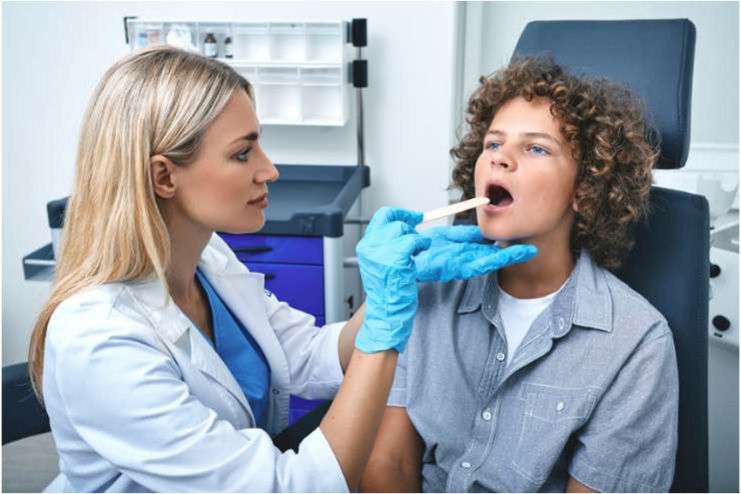Affiliate Disclaimer
Some links in this article are affiliate links. We may earn a small commission if you make a purchase through these links, at no extra cost to you. We only recommend products we find useful to our readersHave you ever seen white dots on your throat and wondered what they might indicate? The odd sight might cause worry, particularly when accompanied by pain or a sore throat. However, these spots aren’t usually a reason for concern, so don’t stress. They might be your body’s method of alerting you to a bacterial illness that requires treatment or something as straightforward as a minor infection.
Since white spots on the throat frequently disclose more than meets the eye, treating them is crucial. These areas provide hints about your general health, ranging from a harmless accumulation of waste to indications of tonsillitis or oral thrush. You can choose the best course of action for therapy, whether a calming home cure or expert medical attention, by being aware of their possible causes. In this tutorial, we’ll look at the causes of white spots and find practical solutions.
Symptoms of White Spots on the Throat?
Although white spots on the throat may not seem concerning initially, they often bring mild or noticeable symptoms you should not disregard. White discoloration can appear on the tonsils alone or all over the mouth and around the tonsils. Besides the white patches, your tonsils may feel scratchy, and you may have trouble swallowing. Additional symptoms, such as white patches on the tonsils, frequently accompany these cases:
- Pain in the throat
- Temperature
- A congested nose
- A headache
- Aches and pains in the body
- An increase in lymph node size
Causes of White Spots on the Throat?

Some significant causes of white spots on the throat are as follows.
1. Strep throat
A Group A Streptococcus bacterium causes strep throat, an infection of the tonsils and throat. You can be exposed to strep germs if you have close contact with someone who has strep throat.
Since strep throat frequently causes tonsillitis, the same factors increase the risk. Children aged around 5 to 15 are more likely to have it. Living or working in a crowded environment, such as a shelter, military training facility, detention or correctional facility, or having frequent close contact with school-aged children may increase your risk of contracting it.
2. Tonsillitis
The medical word for swelling and redness in the tonsils is tonsillitis. The soft tissue lumps in the back of your throat are called tonsils. As a component of your immune system, they aid in capturing pathogens that can cause illness.
Although bacterial infections can also cause tonsillitis, viral infections are the most common cause. The viruses that cause the flu or a cold are responsible for most instances. The most common cause of bacterial tonsillitis is strep throat.
3. Tonsil Stones
Tonsil stones are hardened white deposits that accumulate on the white and are made up of dead cells, food particles, bacteria, and mucus. Although tonsil stones contain various cells that may fight against infection, the tonsils can be affected.
4. Oral Thrush
Sometimes, the bacteria Candida albicans causes an infection in the mouth and throat. This infection is called a yeast infection. Although Candida albicans are always present in our body, infection can occur when they rise. In this condition, along with the throat, white spots may also appear on the cheeks and tongue, causing an alteration in taste.
5. Infectious Mononucleosis
Epstein-Barr virus (EBV) is one of the most common causes of mononucleosis, although other viruses, including cytomegalovirus (CMV), can also cause it.
Spit, blood, and semen are among the bodily fluids via which viruses can travel. Avoiding physical contact, exchanging food or beverages, and sharing personal objects (like toothbrushes) with those who have mononucleosis can all help protect you.
6. Leukoplakia
White or reddish patches in your mouth and throat are a symptom of leukoplakia. Something that irritates the oral lining, like poorly fitted dentures, chewing tobacco, or excessive alcohol consumption, causes it. White spots will typically appear inside your cheeks, tongue, and gums. But you can also acquire spots in your neck and on the roof of your mouth.
7. Oral Herpes
Virus can spread from kissing and sexual contact with an infected person because saliva transmits from herpes type 1 (oral herpes) and herpes type 2 (genital herpes). Herpes can produce a sore throat, flu-like symptoms, tingling sores on the mouth and genitals, and white patches in the mouth or throat. Although there isn’t a cure for herpes, a doctor can help stop an outbreak by prescribing antiviral medicine.
8. Lichen Planus
The skin around your wrists and elbows, the backs of your hands, and the fronts of your lower thighs are the main areas where this inflammatory disease produces a rash. However, almost 50% of lichen planus patients also get it in their mouth. You may notice lacy-looking white patches in your throat, although this commonly begins as little white dots on the skin inside your cheeks or on your tongue. Your physician may prescribe antihistamines, immunosuppressive medications, or retinoids. Alternatively, they could use UV radiation to get rid of the patches.
How to Treat White Spots on the Throat
Specific tips may help you get rid of white spots on your throat. Some of the best tips to remove the white spots on the throat are as follows.
- Your doctor can recommend medications to treat bacterial infections, such as group A streptococcus, that are causing the white patches on your throat. Even if your symptoms go away before you finish the entire course of antibiotics, ensure you take them all.
- Even though viral infections usually go away independently, severe cases can need antiviral drugs to control symptoms and hasten healing.
- Tonsil stones can usually be removed by gargling with salt water, flushing with a water pick, or using a cotton swab to force them out. If you cannot remove the stones or if they reoccur often, see your ENT provider for assistance.
- Acetaminophen or ibuprofen are over-the-counter pain medicines that can help reduce the discomfort and soreness in the throat that comes with white spots.
How to Get Rid of White Spots on Throat Naturally

Follow some of the natural tips provided below to get rid of white spots on the throat in a completely natural way. Importantly, these natural recommendations do not cause any side effects. Here are some of the best natural tips to remove white spots on the throat.
- Regularly gargle with salt water.
- Get a lot of rest
- To soothe a dry and sore throat, sip on warm beverages such as tea with honey.
- Consume smoother foods such as yogurt or ice cream.
- Avoid irritating foods, such as chips, raw vegetables, highly acidic foods, and spicy foods.
- Avoid alcohol and citrus-based beverages. They may cause the spots to swell by irritating them.
- Avoid sharing personal cutlery.
- Steer clear of contaminants, including smoking, tobacco, and vehicle exhaust.
- Dry throat is a common cause of painful white spots on your tonsils. Humidifiers and steam tubs can help raise the humidity level in your space.
Prevention of White Spots on Tonsils
Although people can’t always avoid white spots on their tonsils, they can take various steps to lower their chances of developing them.
- Hand washing frequently lowers the chance of infection.
- Strengthening the immune system with a healthy diet, regular exercise, and rest.
- Covering the mouth and nose when coughing to prevent virus transmission to others and avoiding close contact with infected people
- Maintaining proper oral hygiene, which includes routine dental examinations
When Is the Right Time to Get Medical Advice?

It is imperative to seek medical help for an accurate diagnosis and treatment, particularly if symptoms intensify or persist. Experts advise seeking treatment as soon as possible and avoiding sharing food or beverages until you confirm that your white spots are not contagious. Furthermore, maintaining proper hygiene, which includes washing your hands frequently, can help stop the spread of infectious diseases.
Conclusion
Despite their tiny size, white patches on the throat can have mild to catastrophic consequences. Protecting your health requires early detection of these areas and rapid treatment. Home remedies like honey or saltwater gargles can help, but if symptoms persist, you must see a doctor to rule out underlying illnesses or infections.
-
Aug 2017Written by Prajakt
-
Dec 2024Edited by Ankita
References
- https://www.healthline.com/health/white-spots-on-tonsils#symptoms
- https://www.webmd.com/cold-and-flu/white-spots-throat-causes
- https://www.spartanburgent.com/common-causes-of-white-spots-on-your-throat
- https://www.emedicinehealth.com/what_causes_white_spots_in_your_throat/article_em.htm
- https://lifemd.com/learn/what-causes-white-spots-on-the-back-of-the-throat
- https://yourdoctors.online/white-spots-on-throat-causes-and-treatment/
- https://www.medicalnewstoday.com/articles/317891#prevention
In this Article


















